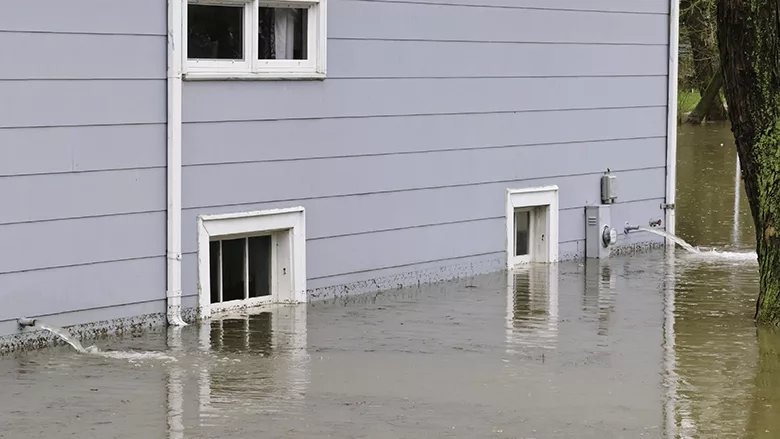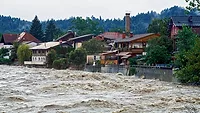Innovative Solutions for Effective Stormwater Management in Urban Environments

Urbanization is on the rise, with more people choosing to call cities their home. While this movement brings countless advantages, it also poses significant challenges, particularly in stormwater management.
In densely populated urban areas, the efficient control and mitigation of flooding caused by intense rainfall is paramount. To tackle this issue, engineers, urban planners and environmentalists are hard at work developing innovative solutions for effective stormwater management.
Urbanization and Stormwater Challenges
As urban landscapes expand and grow, impermeable surfaces such as roads, parking lots and buildings often replace the natural terrain. This transition disrupts the natural water cycle, resulting in an increased volume of water runoff during rainfall.
Inadequate drainage systems and aging infrastructures compound the problem, leading to urban flooding, property damage and even injury or loss of life.
Rapid industrialization and urban growth are some of the main causes of this issue. The Industrial Revolution led to rapid urbanization in the late 18th century, as people flocked to cities in search of employment in factories. This unprecedented growth strained existing infrastructure and led to poorly planned, densely populated areas.
In the 19th and early 20th centuries, urban planning was often inadequate, if it existed at all. Cities expanded haphazardly, resulting in irregular street layouts and insufficient drainage systems. Lack of comprehensive planning exacerbated stormwater management issues.
Furthermore, many older cities have aging stormwater and sewage infrastructure that cannot handle the volume and intensity of rainfall seen today. Over time, these systems have deteriorated, leading to frequent leaks and overflows. Climate change has also led to more frequent and intense storms. Urban areas are ill-prepared to handle such rapid influxes of water, causing flooding and infrastructure damage.
One of the most notable incidents is Hurricane Katrina, which struck in 2005. The failure of stormwater management systems in New Orleans during Katrina led to catastrophic flooding. Levee breaches and inadequate drainage systems caused widespread devastation. The storm claimed over 1,800 lives, making it one of the deadliest natural disasters in U.S. history. This event led engineers to rethink stormwater management regarding urban planning and architectural design.
Professionals in various fields — including restoration and remediation technicians — have collaborated to devise innovative stormwater management strategies to address these issues. These experts are crucial in assessing water damage and restoring affected areas to their pre-storm conditions. They assist in detaining stormwater, removing pollutants, and implementing green infrastructure to capture and reuse stormwater.
In addition, professionals can provide consultation on the proactive management of manufactured lakes and stormwater pounds in urban areas, which involves maintaining a healthy aquatic ecosystem through measures such as dredging and biomanipulation techniques, stabilizing shorelines, and using nutrient remediation methods.
To combat the effects of climate change, communities, businesses, governments and individuals are adopting sustainable practices.
Green Infrastructure
One of the most promising developments in urban stormwater management is incorporating green infrastructure. This strategy aims to restore natural hydrological processes within urban areas.
Green infrastructure includes a variety of features such as green roofs, permeable pavement, bioswales and rain gardens. These elements capture and slow the flow of water, allowing it to naturally filter and absorb into the ground.
Green Roofs
Green roofs are innovative architectural features that introduce vegetation to the rooftops of buildings. They serve a dual purpose — enhancing urban aesthetics and contributing to effective stormwater management. Restoration and remediation professionals assist in assessing the structural integrity of buildings, and ensure proper installation and maintenance of the vegetative roofing system.
By using specialized growth mediums, green roofs absorb and retain rainwater, reducing the overall volume of water runoff. They collect between 40% and 80% of rainwater and release it slowly. Green roofs also act as natural insulators, improving energy efficiency and air quality, and reducing the urban heat island effect.
Rain Gardens
Rain gardens — or bioretention areas — are landscaped areas specifically designed to capture and manage stormwater runoff. These aesthetically pleasing features utilize a variety of native plants and specially engineered soil to absorb, filter, and slow down the flow of rainwater.
They help reduce flooding by allowing water to percolate into the ground, minimizing the burden on conventional drainage systems. Beyond their flood control benefits, rain gardens also enhance urban biodiversity and provide habitats for wildlife, creating green pockets within city landscapes.
Bioswales
Bioswales are engineered landscape features designed to channel and manage water runoff effectively. These vegetated channels or ditches are typically lined with vegetation and soil engineered to capture and treat rainwater as it flows.
By filtering out pollutants and allowing water to infiltrate the ground, bioswales reduce the burden on stormwater infrastructure and prevent urban flooding. They are pivotal in enhancing water quality and promoting a more sustainable approach to urban water management.
Rainwater Harvesting
Rainwater harvesting has gained prominence as a sustainable solution to stormwater management in urban areas. The collected water can be used for irrigation, toilet flushing and cooling systems. By diminishing the volume of stormwater entering conventional drainage systems, rainwater harvesting alleviates the strain on infrastructure and conserves freshwater resources.
Urban Tree Canopies
Urban tree canopies comprise the network of trees within urban environments, offering several significant benefits, including stormwater management. Trees are critical in reducing the risk of flooding by absorbing rainwater and releasing it back into the atmosphere through transpiration.
Moreover, they provide shade, which cools urban areas and decreases evaporation rates. By expanding and preserving urban tree canopies, cities can enhance their resilience to extreme weather events while improving air quality.
Permeable Pavement
Permeable pavement is a pioneering solution to urban flood control that transforms traditional impervious surfaces into permeable ones. These surfaces allow rainwater to infiltrate through the pavement and into the ground below, thus reducing runoff and preventing flooding.
They can take various forms, such as porous concrete, pavers or asphalt — each offering a resilient and efficient way to address stormwater management in urban areas. By replacing conventional roads, parking lots and sidewalks with permeable alternatives, cities can drastically reduce the risk of flooding and improve water quality through the natural filtration of pollutants.
Green Streets
Also known as eco-friendly or sustainable streets, green streets are an effective stormwater management tool. Key features include using permeable pavements, strategically planted trees, and the integration of bioswales and rain gardens, combining multiple green technologies.
This multifaceted approach allows green streets to capture and filter rainwater, curbing the volume of runoff that can lead to flooding. In addition to their flood control benefits, they improve air quality, urban cooling and aesthetic enhancements, transforming urban environments into more sustainable and pleasant places for residents to live and work.
Underground Storage and Detention Systems
In highly developed urban areas with limited space for green infrastructure, underground storage and detention systems provide an effective alternative. These systems consist of underground tanks or chambers designed to store excess stormwater.
By temporarily holding water during heavy rainfall, they prevent downstream flooding and can slowly release it when the storm has passed. This controlled release of water reduces the pressure on drainage systems and minimizes the risk of urban flooding.
WaterGate Rapid Solution
WaterGate is a versatile and rapidly deployable flood barrier system. During flooding, its innovative design allows companies to install it quickly to protect critical infrastructure and homes. The barrier consists of lightweight, modular elements that one can easily assemble, providing an effective defense against rising waters.
Whether used to secure access points, shore up embankments or protect vulnerable areas, WaterGate offers a flexible and scalable solution to urban flood control. Its adaptability and rapid deployment capabilities make it a valuable tool for mitigating the immediate impacts of flooding, and reducing damage to both public and private property.
Smart Stormwater Management
The digital age has brought a wealth of opportunities for more efficient stormwater management. Smart systems use advanced sensors, data analytics, and real-time monitoring to predict and respond to storm events.
These systems can autonomously adjust water levels in storage tanks, control water flow, and provide early warnings to relevant authorities and residents. By optimizing stormwater management in this way, one can mitigate the impact of heavy rains more effectively.
Flood Guards
Flood guards are a state-of-the-art fluid monitoring and prediction system that provides timely and accurate information during potential floods. A flood guard continuously monitors weather conditions, river levels and other critical parameters, and is equipped with a network of sensors and advanced data analytics.
When adverse weather patterns indicate an increased risk of flooding, the system issues early warnings to relevant authorities and communities, allowing them to implement precautionary measures and evacuate residents if necessary. This proactive approach to flood management is invaluable in reducing property damage, protecting lives and enhancing the overall resilience of urban areas.
Preparation
In emergency response situations, it is always important to ensure adequate preparation. Creating emergency action plans, implementing advanced early warning systems, developing evacuation plans, and maintaining stockpiles of emergency resources can help ensure individuals and communities are better prepared in the event of a storm.
Additionally, a utility trailer can be a valuable tool in an emergency situation. These trailers are purpose-built to transport essential supplies and equipment to affected areas swiftly, effectively turning them into a lifeline for disaster-stricken communities. However, it’s important to select aluminum over steel trailers, as steel is vulnerable to water exposure and has a tendency to rust.
Resilient Infrastructure
Climate change is increasing the frequency and intensity of storms, making it essential for cities to adopt resilient infrastructure. Modular systems — which one can adapt and expand — provide cities with the flexibility to adjust to changing storm patterns and growing urban populations.
By embracing resilient infrastructure, cities can reduce the long-term costs associated with stormwater management and enhance their ability to control urban flooding.
Urban Planning and Design
Effective stormwater management starts with adequate urban planning and design. Forward-thinking city planners are incorporating stormwater management into their plans from the outset, integrating green spaces, sustainable drainage systems and flood-resistant infrastructure into the urban landscape. By doing so, they’re not only mitigating the effects of stormwater but also creating more livable, sustainable cities.
These advanced stormwater management solutions offer resilient, sustainable and highly effective ways to address urban water challenges. By combining and customizing these techniques to fit the specific needs of a given urban environment, stormwater professionals can help mitigate the adverse impacts of urbanization, and protect lives and property during extreme weather events.
Adopting Innovative Solutions for Stormwater Management
Increasing numbers of people are living in cities nowadays. Unfortunately, most of the structures they currently live in were not built in a time when effectively draining flood water was essential. Urbanization may bring about numerous challenges, but it also serves as a catalyst for innovation.
Cities worldwide are actively seeking new and sustainable ways to deal with flooding and protect their residents. A team of professionals bring their expertise in assessing water damage, implementing green infrastructure measures and ensuring compliance with stormwater management regulations in order for these solutions to be effective.
By embracing cutting-edge solutions, urban areas can adapt to climate change’s challenges and enhance the overall quality of life.
Sources
5 New Flood Prevention Products to Replace Sandbags. https://design1st.com/5-innovative-flood-prevention-products-replace-sandbags/.
A Case for Enclosed Trailers. https://www.trailersuperstore.com/a-case-for-enclosed-trailers/.
Fact Sheet: Nature as Resilient Infrastructure – an Overview of Nature-Based Solutions. https://www.eesi.org/papers/view/fact-sheet-nature-as-resilient-infrastructure-an-overview-of-nature-based-solutions.
How Hurricane Katrina Changed Thinking on Risk and Resilience. https://www.enr.com/articles/49944-how-hurricane-katrina-changed-thinking-on-risk-and-resilience.
Soak up the Rain. https://www.epa.gov/soakuptherain.
World Bank Report Illustrates Benefits of Resilient Infrastructure. https://sdg.iisd.org/news/world-bank-report-illustrates-benefits-of-resilient-infrastructure/.
Looking for a reprint of this article?
From high-res PDFs to custom plaques, order your copy today!








